Until you’ve been climbing long enough to get used to it, there is always that moment of hesitation, even disbelief. You are at the very top of a whitebark pine (pinus albicaulus) tree, where the main trunk narrows down to four inches or so in diameter, and the cones you are here to cage and protect for later harvest are still eight feet or more above you.
You tie your main line — your rappel rope, your lifeline, your deity — around the trunk, and you pull out enough slack to allow you to keep climbing to where you have to be. The high country winds are blowing, and the tree sways with you like a mighty ship on a moderate sea.
Suddenly, you are very aware of the long distance between you and the earth. You check your harness one more time, make sure your flip rope is clear and ready to clip, and dance lightly upward, looking dry-mouthed for that perch, those limbs that will let you do your work without the extreme yoga-pretzel stretches that wear you down.
Fear is exhausting: you avoid it with climbing skill and by having your ropes and carabiners clean and at the ready. When finally in the crown of the tree, the cones within reach, you use your flip rope to gather as many small branches as you can, clip the end to your harness, reach down with your right hand and cinch it down, making a strong anchor. Straighten legs to relieve muscles, lean into your harness and trust your gear, shake out your hands and forearms, study the bounty of dark mahogany-colored cones before you, the cones that may hold the key to preserving one of the most ecologically crucial and most beautiful trees on the planet.
The Toughest Most Noble Tree
Since the summer of 2009, I’ve been part of a crew of independent contractors working seasonally on whitebark pines for the US Forest Service. The work begins in July, placing screen cages over cones on selected healthy trees to protect them from the birds and squirrels so they can be harvested in September.
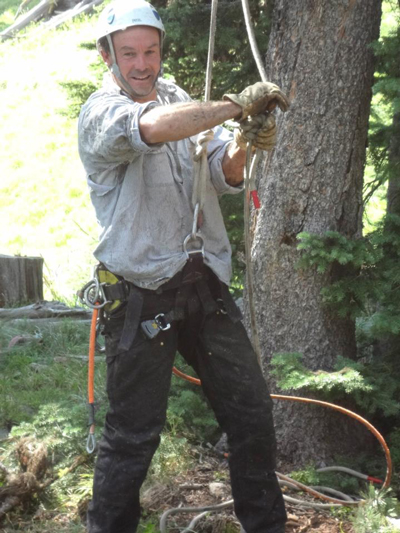
It ends in the cold of October or November, when the trees go dormant and we cut scion – the fresh shoots of new growth from mature trees, which can be grafted onto young rootstock grown from seeds, to speed up the process of producing cones. The whitebark, like all five needle pines, inhabits a slower world than we do, and does not naturally produce cones until it is eighty years old or older.
We’ve climbed trees from the Wind River Range and the Yellowstone to Hungry Horse, the Pioneers, the Bitterroots, and most of the ranges in between. It’s a hard job, long days in all kinds of weather, sap-stuck carabiners, sap-stuck eyelids, shredded leather gloves and workshirts, too many calories burned to replace, and thousands of miles of road between harvest areas.
But it has become one of the best jobs I’ve ever had, and everyone on our crew feels the same. We all started out high-country addicts, skiers and mountaineers and alpine wanderers, and the whitebark pine was always our tree, the wind-trained, bottle-brush-shaped icon, the toughest most noble inhabitant of the highest and the wildest places.
As Whitebarks Go, So Goes The Ecosystem
Consider the current plight of the whitebarks: in 1909 or 1910, a shipment of white pine seedlings from France or Germany to Vancouver, British Columbia brought with it a blister rust native to Eurasia. Since then, the blister rust has been burning through all of our five needle pines, the magnificent timber-producing white pines, the ancient bristle cones, the medium-elevation limber pines, and the high-altitude whitebarks.
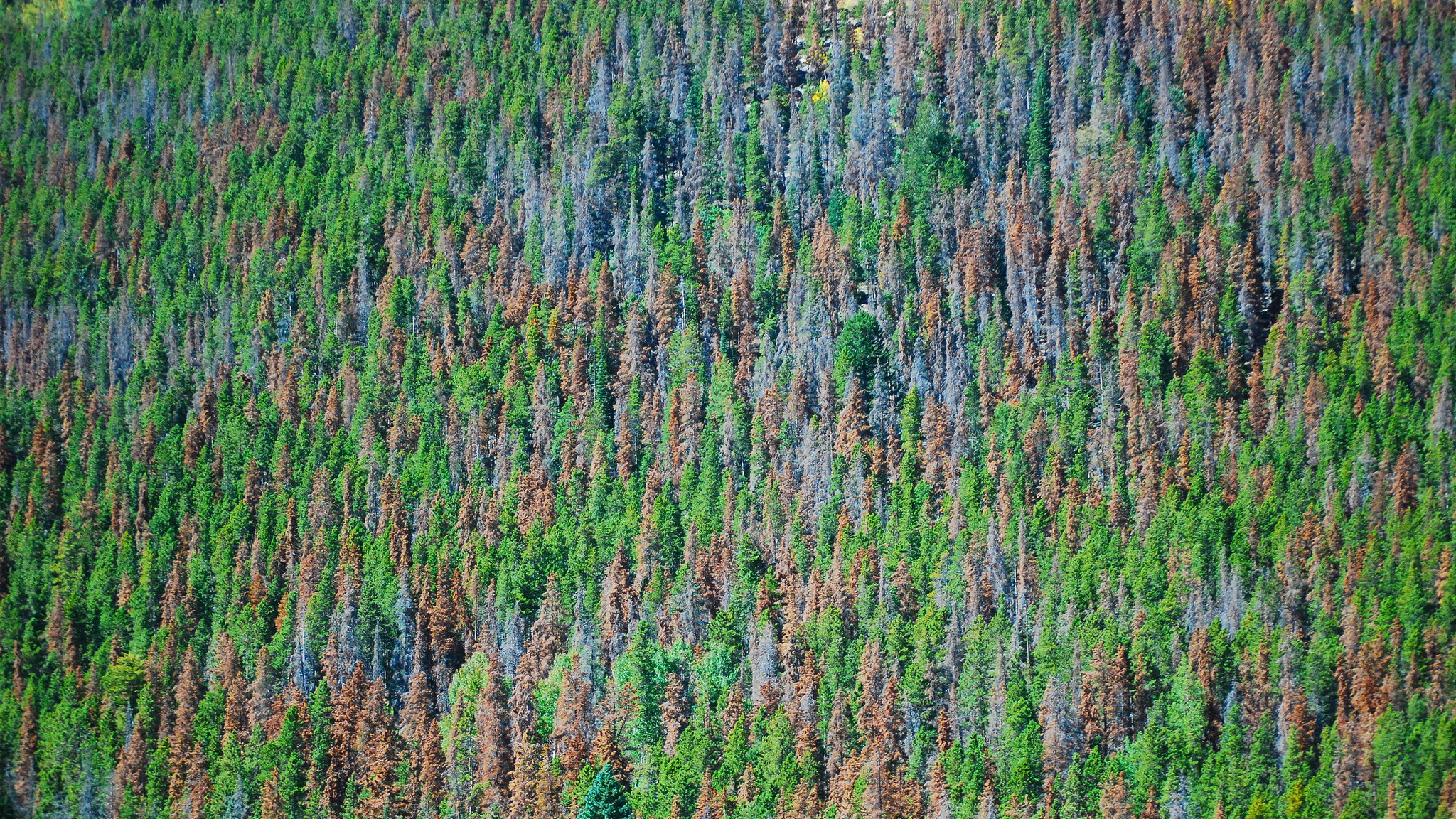
In the past decade, the five needle pines have faced yet another scourge with the explosion of the mountain pine beetle, a native species that, with the advent of warmer temperatures due to climate change, can produce two broods of young per year, and on particularly warm years, experiences no winter die-off at all.
The destruction of the whitebarks has been particularly dramatic – in many parts of the Rockies, over 80% of them are dead, leaving behind vast expanses of ghost forests where the wind moans through the skeletons of trees that were once some of the oldest living inhabitants of North America (there is a living whitebark pine in the Sawtooth National Forest of Idaho that is 1,270 years old.)
With them goes an entire ecosystem. Twenty major species of wildlife depend on the seeds of the whitebark, and over 80 species of birds, and with little wonder: the seeds within the cones are a deep ivory color, glistening with nourishment.
One gram of whitebark seeds contains over 7200 calories, 60% of which is fat, 21% protein. The Clark’s nutcracker, the big showy gray and white corvid, co-evolved with the whitebark directly because of this rich source of feed. Grizzly bears depend on these seeds during their fall period of hyperphagia (eating voraciously to build fat reserves for the winter).
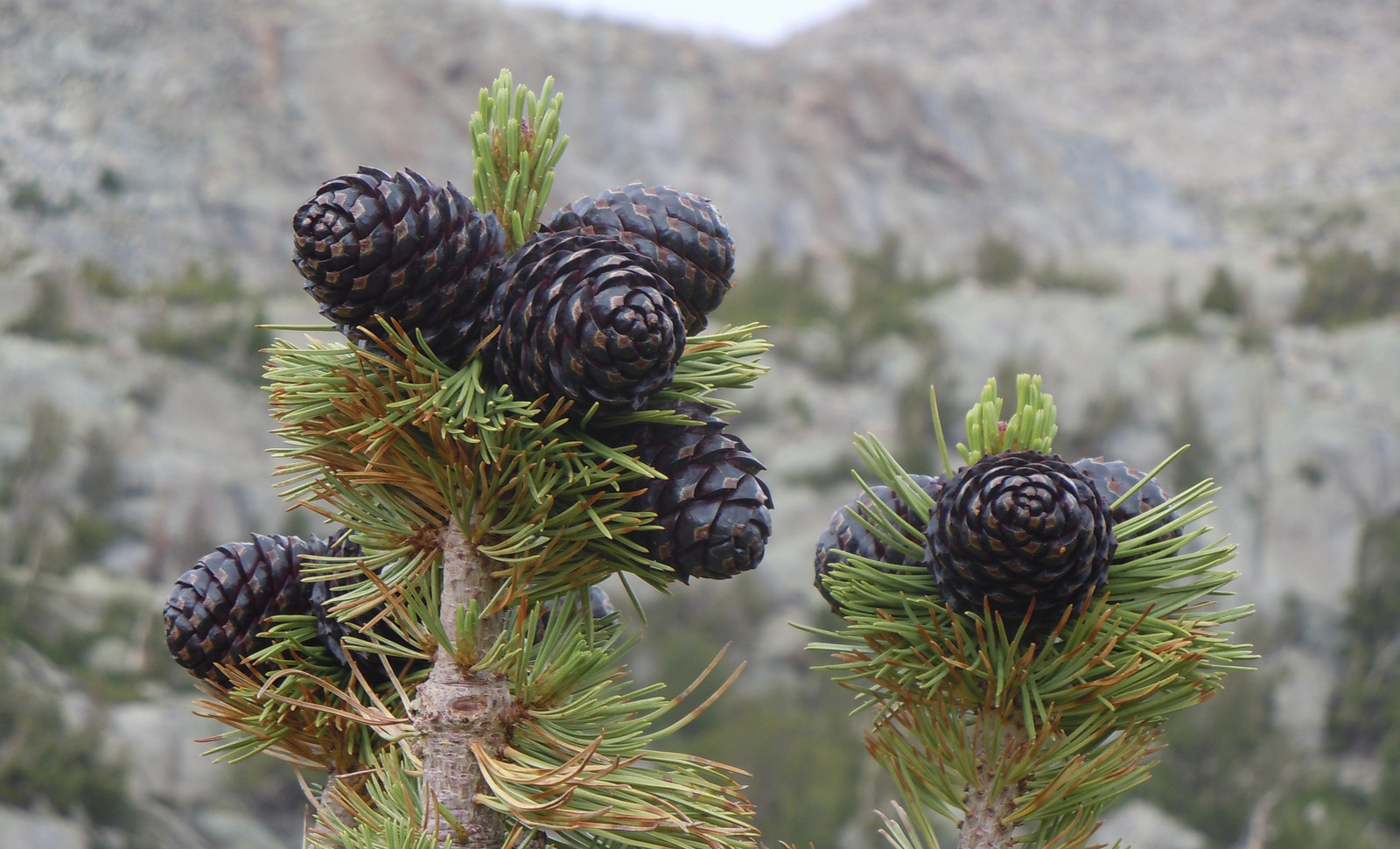
Most critically for the grizzlies, the whitebarks are a potent food source that keeps them up high, out of sight and out of trouble in a world where human beings dominate the lower-elevation landscape. (When harvesting cones, we use stout leather gloves to protect our hands from the harsh spikes and the thick clear pitch that shields them from high altitude sunlight. Biologists say that black bears, which can climb well, meticulously pick the seeds from the cones. Grizzlies, in keeping with their reputation, raid the ground-caches of cones made by squirrels, and simply devour the cones whole, an almost unimaginable feat.)
The whitebark is also crucial to the supply of water in the arid Rocky Mountain West. It’s the biggest tree that can grow at the highest altitude. Its’ dense canopy and odd bottle brush shape is perfect for catching snow, and for shading the snowpack below, keeping the snowpack from piling up and then melting in a torrent during the first warm days and rains of spring. Whitebark roots anchor the thin alpine soils to prevent erosion, and catch the seeds of the plants that hold it all together, and again, keep the snowpack from pouring away in flood. Without them, the West faces a much drier and more difficult — some might even say dystopian — future.
Enter the Cone Harvesters
That future, though, is far from settled.
The work our harvest crew has been doing is directed by some of the best minds in modern forestry, and due to a vast amount of hard and painstaking scientific effort, backed up by good old fashioned labor, there is ample hope for the survival of the whitebark and the ecosystem it supports.

Unbeknownst to me when we began this work, a no-nonsense US Forest Service geneticist named Mary Frances Mahalovich had already been traveling the high Rockies for more than a decade, studying the ruined forests with a pathologists’ eye, seeking out the genetic supertrees that were thriving in the face of beetles and rust and drought.
These supertrees are called “plus trees” which Mahalovich describes, in her customary lack of hyperbole, as “live trees, above average in appearance, and actively producing cones.”
Mahalovich and her team have so far identified over 1300 plus trees, in 343 different areas of whitebark habitat. Crews like ours have been harvesting cones from those trees every season, and the US Forest Service nursery in Coeur d’Alene, Idaho, has been extracting the seed and growing seedlings to the tune of 180,000 to 200,000 per year.
The seedlings are planted by crews with hoedads (a flat-bladed tool with a handle like an axe), often the year following a wildfire, on National Forest lands. The record planting, so far, for one season has been 235,000 seedlings, a record of which Mahalovich is extremely proud. “But,” she makes clear, “the extent of the dieoff is such that we could plant 2000 acres of whitebarks per year and stay busy for the next 400 years.”
Seedlings are also used for research in the ongoing attempt to find the most blister rust resistant trees. “We’ll test our two year old seedlings for resistance by exposing them to rust spores, carried on a ribes (currant) leaf,” Mahalovich explains.
Blister rust requires a “middleman” to do its deadly work in the forests, she said, using as a host either the ubiquitous ribes, or, less commonly, lousewort and Indian paintbrush. So far, the outcomes for rust-resistance in the seedlings are pretty good.
“By three years of age (for the seedlings) we can determine if they are resistant or not. Between 1999 and 2005, we were finding rust-resistance in 28-54% of our seedlings, depending on where the seeds came from. Now, the average has leveled out to between 10% and 30% rust resistant, overall.”
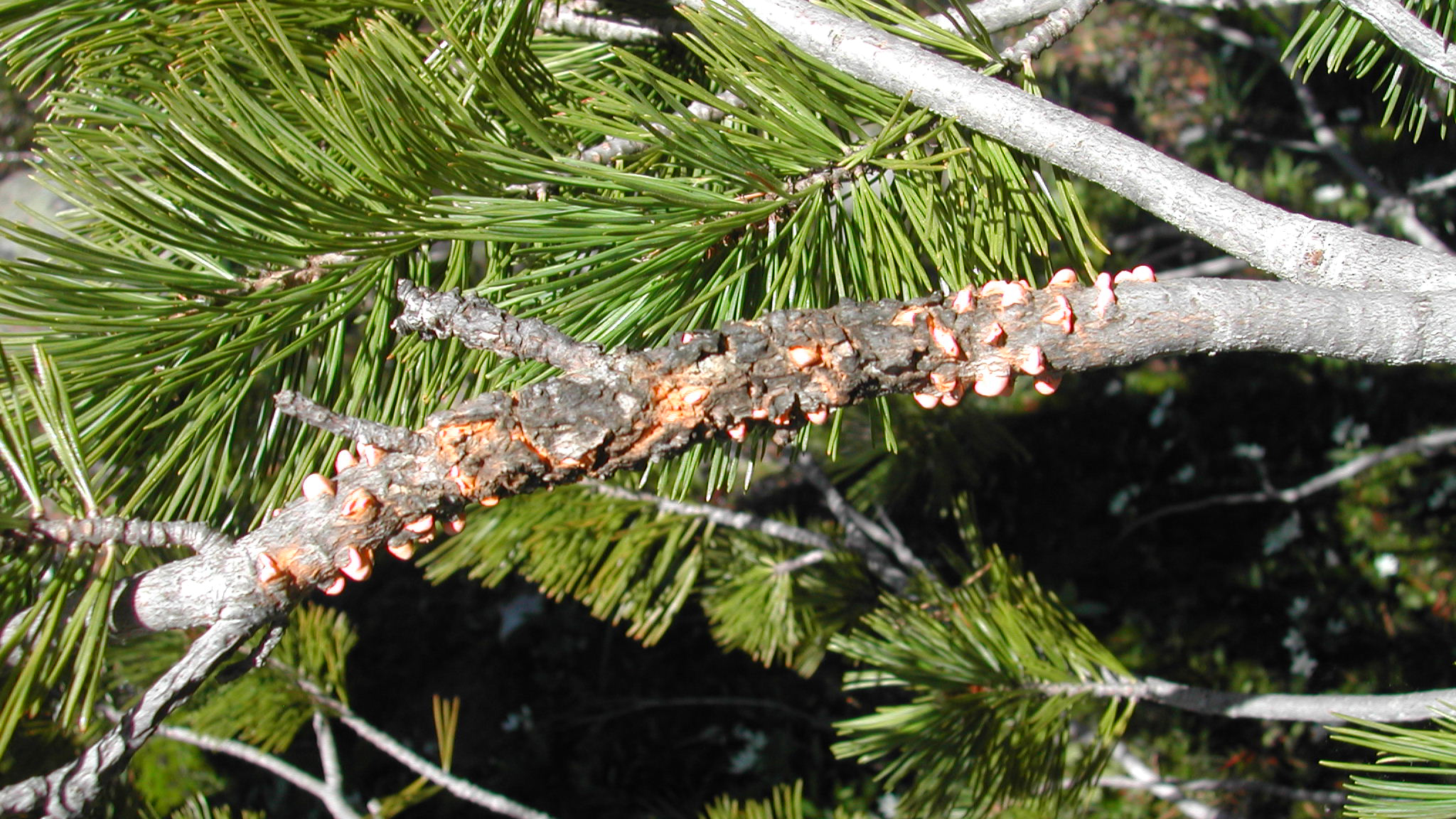
Our crew and others like it will be busy for a few years to come, but we are certainly working ourselves out of a job. The scion we cut in the cold months is grafted onto the rootstock grown from the seeds extracted from the cones we harvest, and that rootstock produces the cones that the Forest Service will one day no longer have to pay us to cage and harvest.
“That scion – it’s really just a branch tip- remembers how old it is,” Mahalovich says. “It will start producing cones, behaving like an 80 year old, even though it is grafted onto a seedling that is only three to six years old.”
We know the problem, and we have the tools and the technology to fix it.
John Schwandt
Mahalovich told me that, for a more complete portrait of the whitebarks work, I’d have to contact Dr. John Schwandt, the dean of whitebark research and recovery. Dr. Schwandt retired two years ago after forty years of work as a forest pathologist for the state of Idaho and for the US Forest Service.
For the last ten years of his work, he was the coordinator of the National Whitebark Pine Restoration Program, based in Couer d’Alene. Schwandt, like his colleague Mahalovich, sees himself as a problem solver, whose great luck it has been to spend his career working on one of the most distressing forest pathology events of our age, and to have been there through the seminal efforts at addressing that event.
“In 1998,” Schwandt said, “I was asked to identify, harvest, and deploy rust-resistant whitebark pines, and I had to do it in five years, with no increase in my budget. And that is what we did.”
Schwandt said he started the project in “areas of very high blister rust infection” one of which was around Big Mountain, the renowned ski area near Whitefish, Montana. “We branched out through northern Idaho and western Montana, always looking for that one uncankered [uninfected] tree to harvest.” In places, such trees were very few and far between. The massive forest fires of 2000 brought home to everyone just how critical the situation for the whitebarks was. “That fire season really kicked us off,” he says.
I asked him what it has meant to him, to be on the forefront of this work, for so long.
“Meant? Well, on all fronts this is a man-made problem,” he says. “We have climate change and we have the introduction of the rust. We know the problem, because we caused it, and we have the tools and the technology to fix it. This is our opportunity to fix something for a foundational species. We can bring it back.”
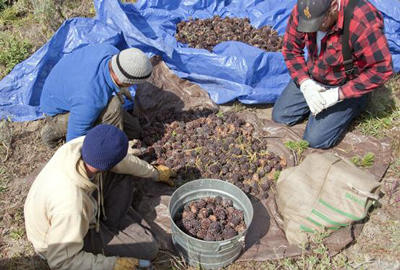
Schwandt is still working on whitebarks in his retirement, and is researching ways to use direct seeding of planting areas, rather than having to undergo the expensive process of growing seedlings, transporting them and planting them by hand.
He added, as part of explaining how and why this work has held him for so long, “The places you get to go with this work,” he says, “are some of the most breathtaking country anywhere in the world.” To further that explanation, he tells a quick story.
“We were out one day in September, and I was watching this Clark’s nutcracker flying from tree to tree, and he was dropping whitebark seeds all over the place. I went to see what he was doing,” he says.
“It cost us 71 cents to collect one seed, and here they were flying all over,” Schwandt continues. “The nutcracker was just wasting them. I thought maybe we could just pick them up and use them. But when we went and picked them up, we found that each one he dropped was empty (non-viable). This bird had the ability to pick those seeds and then, in flight, to sort through them by weight. Now that is real intelligence.”
It is the intelligence of one bird, but it is also the intelligence of a place, of an ecosystem complex and vibrant beyond our imaginings.
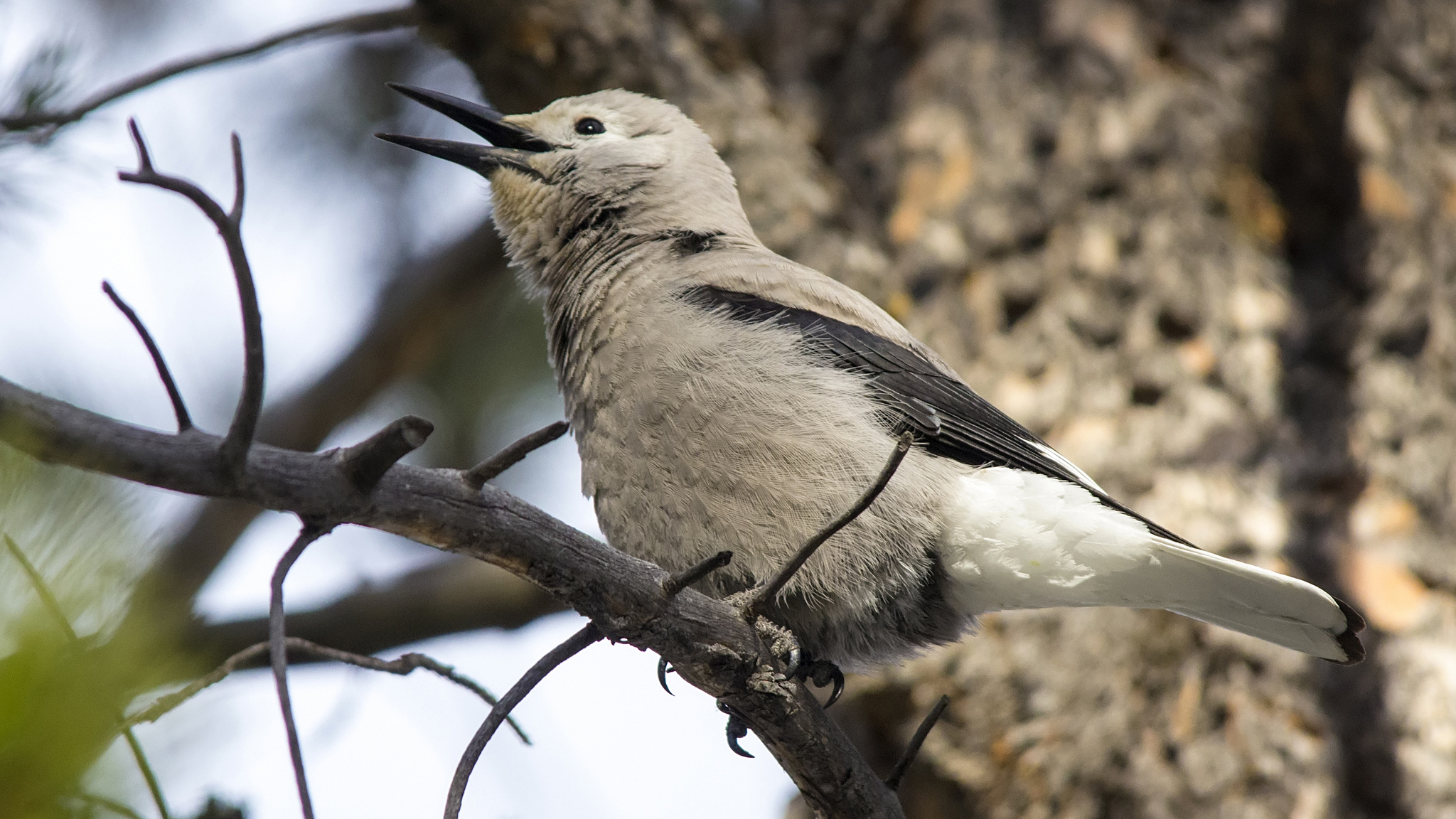
Deep in the canyon of the South Fork of the Teton River, the early snows of last week linger in the shade and on the north sides of the rocks. We cross the little river — here no more than a dozen feet wide, with rings of clear ice around the rocks at midstream — and take the trail leading up and into the massive tumble of gray stone known as Montana’s Rocky Mountain Front.
We’re going up high, yet again, to a pass that leads into the Bob Marshall Wilderness, to harvest scion from whitebarks bonsai’d and twisted by the Front’s legendary wind. By the time we get there, hands and hips and knees warmed by the long uphill, it is mid-morning, a great autumnal silence reigns, the waiting between equinox storm and the onset of real winter.
We uncoil ropes from packs, shake out climbing harnesses, limber up gloves black with cold-hardened pitch. Two trees left to go. Another season coming to an end, here near the top of the world.
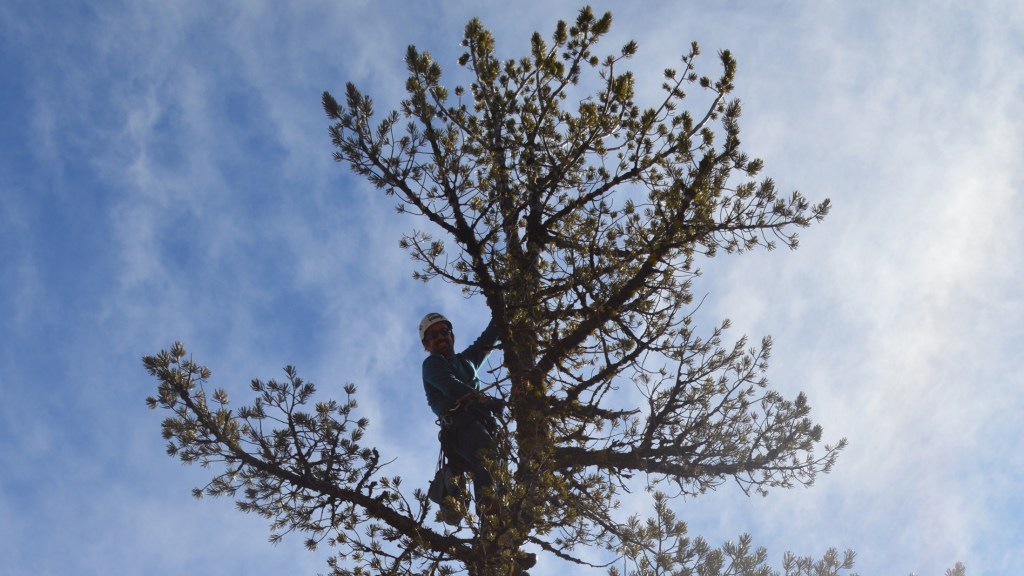



yes man made problems. and man centered solutions (hopefully)
Hi, I’m Andy Pershern, DIVIDE, MONTANA. I have land at 6200 ft on the west slope of the Humbugs near the Highlands. I’ve found what I believe is Whitehall pine, twin trunks, say 70 feet high . I have 1 5 foot tall one below it. I just picked a 5 gallon buck of this seasons drops, are these usable for me to seed with??? Its the only one on this mountain slope I’ve found. I’m sure more exist up on top somewhere in the Humbug Spires. Ill be looking for them now!!!! Apmtnrivers@gmail.com.
Brilliant writing and powerful work for ecosystem and trees Very moving. Especially the connection between the bird and seeds is pure poetry. That is how nature is. Thanks
Is it one gram = 7200 cal? Or is it 1 kg=7200 cal?
Thank you for the question! Here is the information from the Forest Service: http://www.fs.fed.us/database/feis/plants/tree/pinalb/all.html
“Palatability/nutritional value: Whitebark pine seeds are highly nutritious. They are especially high in lipids. Content of seed collected from the Gallatin National Forest was 52% fat, 21% carbohydrate, 21% protein, 3% ash, and 3% water. Major minerals present were copper, zinc, iron, manganese, magnesium, and calcium [121]. Energy content of fresh, mature whitebark pine seed collected on the Bridger-Teton National Forest ranged from 5,526 to 7,308 calories/g (µ=6,800 calories/g) [89,115]. Tomback [204] reported similar energy values (µ=7,716 calories/g) for whitebark pine seed from the Sierra Nevada.”
Great piece!